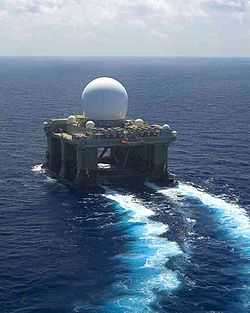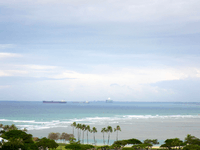Sea-based X-band Radar

The Sea-Based X-Band Radar (SBX-1) is a floating, self-propelled, mobile radar station designed to operate in high winds and heavy seas. It is part of the U.S. Defense Department Ballistic Missile Defense System.
The radar is mounted on a fifth generation CS-50 twin-hulled semi-submersible drilling rig. Conversion of the vessel was carried out at the AmFELS yard in Brownsville, Texas; the radar mount was built and mounted on the vessel at the Kiewit yard in Ingleside, Texas, near Corpus Christi. It is nominally based at Adak Island in Alaska (though, as of November 2013 has never put into port at Adak) but can roam over the Pacific Ocean to detect incoming ballistic missiles. The vessel is classed by ABS and has the IMO number of 8765412.
Specifications
- Vessel length: 116 meters (380 ft)
- Vessel height: 85 meters (280 ft) from keel to top of radar dome
- Vessel draft: approximately 10 meters (32 ft. 9 in.) when in motion or otherwise not on station; approximately 30 meters (98 ft. 5 in.) when on station
- Vessel stability: remains within 10 degrees of horizontal on station (fully passive stabilization)
- Cost: $900 million
- Crew: Approximately 75-85 members, mostly civilian contractors
- Radar range: 2,000 km (1,242 mi.)
- Displacement: 50,000 tons
Details
SBX-1 is part of the Ground-Based Midcourse Defense (GMD) system being deployed by the MDA. Being sea-based allows the vessel to be moved to areas where it is needed for enhanced missile defense. Fixed radars provide coverage for a very limited area due to the curvature of the Earth. The primary task SBX will carry out is discrimination (identification) of enemy warheads from decoys, followed by precision tracking of the identified warheads.
The vessel has many small radomes for various communications tasks and a central, large dome that encloses and protects a phased-array, 1,800 tonne (4,000,000 pound) X band radar antenna. The small radomes are rigid, but the central dome is not - the flexible cover is supported by positive air pressure amounting to a few inches of water. The amount of air pressure is variable depending on weather conditions.
The radar antenna itself is described as being 384 m2 (4,130 sq ft). It has a large number of solid-state transmit-receive modules mounted on an octagonal flat base which can move ±270 degrees in azimuth and 0 to 85 degrees elevation (although software currently limits the maximum physical elevation to 80 degrees). The maximum azimuth and elevation velocities are approximately 5-8 degrees per second. In addition to the physical motion of the base, the beam can be electronically steered off bore-sight (details classified).
There are currently 22,000 modules installed on the base. Each module has one transmit-receive feed horn and one auxiliary receive feed horn for a second polarization, so there are 44,000 feedhorns. The base is roughly 2/3 populated, with space for installation of additional modules. The current modules are concentrated towards the center, so as to minimize grating lobes. This configuration allows it to support the very-long-range target discrimination and tracking that GMD's midcourse segment requires. The array requires over a megawatt of power.
In addition to the power consumed by the radar, the thrusters which propel the vessel are electric and require substantial power. The maximum speed is approximately 8 knots (9.2 mph; 15 km/h). To support this and all other electrical equipment, the vessel currently has six 3.6-megawatt generators (12-cylinder Caterpillar diesels). The generators are in two compartments, one port and one starboard. The maximum power currently drawn is roughly 12 megawatts, and there are plans to expand the number of generators to eight, so that one entire compartment could be lost and the vessel would still continue to operate at full capability.

The active electronically scanned array radar is derived from the radar used in the THAAD theater ballistic missile defense system, and is a part of the layered ballistic missile defense (BMDS) program of the United States Missile Defense Agency (MDA). One important difference from Aegis is the use of X band in the SBX. Aegis uses S band, and Patriot uses the higher-frequency C band. The X band frequency is higher still, so its shorter wavelength enables finer resolution of tracked objects. The radar is designed and built by Raytheon Integrated Defense Systems for Boeing, the prime contractor on the project for MDA.
The radar has been described by Lt. Gen Trey Obering (director of MDA) as being able to track an object the size of a baseball over San Francisco in California from the Chesapeake Bay in Virginia, approximately 2,900 miles (4,700 km) away. The radar will guide land-based missiles from Alaska and California, as well as in-theatre assets.
The CS-50 semi-submersible rig on which the radar is mounted was built as the "Moss Sirius" at the Vyborg Shipyard (Выборгский судостроительный завод) in Russia for Moss Maritime (now part of the Saipem offshore company). It was purchased for the Sea-based X-band Radar project by the Boeing company, outfitted with propulsion, power and living quarters at the AmFELS shipyard in Brownsville, Texas, and integrated with the radar at the Kiewit yard in Ingleside, Texas.

The first such vessel is scheduled to be based in Adak Island, Alaska, part of the Aleutian Islands. From that location it will be able to track missiles launched toward the US from both North Korea and China. Although her homeport is in Alaska, she will be tasked with moving throughout the Pacific Ocean to support her mission. The name given to the SBX vessel, "SBX-1," indicates the possibility of further units of the class. In circumstances when a vessel is required to be continually on duty over a long period of time, common naval practice is to have at least three units of the type available to allow for replenishment, repair and overhaul. Three further vessels of the CS-50/Moss Sirius design were under construction or contract at the Severodvinsk Shipyard in Russia as of early 2007, but were configured for oil production. On May 11, 2011, Col. Mark Arn, the SBX project manager for MDA, said that SBX is only one of its kind and there are no current plans for another one.[1] In July 2011, a Missile Defense Agency spokesman explained that other, smaller radars in the Pacific will "pick up the slack" while SBX is in port with its radar turned off.[2]
Operational history
The SBX deployed in 2006. The ship has spent time for maintenance and repair at Pearl Harbor, Hawaii several times, including 170 days in 2006, 63 days in 2007, 63 days in 2008, 177 days in 2009, and 51 days in 2010. When not at Hawaii, the SBX has been on operational deployments in the Pacific, including traveling to waters off Alaska. The ship has not moored at Alaska, in spite of the construction of a $26 million, eight-point mooring chain system installed in 2007 in Adak's Kuluk Bay. On June 23, 2009, the SBX was moved to offshore Hawaii in response to a potential North Korean missile launch. Between 2009 and 2010, the vessel spent 396 continuous days at sea.[3]
The SBX failed during a flight test on January 31, 2010, designated FTG-06. The test was a simulation of a North Korean or Iranian missile launch.<ref name="US anti-missile test of 'Iran or N Korea' attack fails "[4] The test failure arose from two factors, the first being that algorithms in the SBX radar software which are designed to filter out extraneous information from the target scene were left disengaged for the test, and the second was a mechanical failure in a thruster on the kill vehicle.[5]
During flight test FTG-06a on December 15, 2010, the SBX performed as expected, but intercept of the target missile was again not achieved.
In May 2011, the SBX-1 entered Vigor Shipyard (formerly the Todd Pacific Shipyard) in Seattle for a $27 million upgrade and maintenance work by contractor Boeing.[6] The work was completed in about three months and in August 2011, SBX-1 departed Seattle for deployment.[7]
In February 2012, the Missile Defense Agency requested only $9.7 million per year for Fiscal Years 2013 through 2017, down from $176.8 million in fiscal 2012. This reduced amount would be used to maintain SBX in a “limited test support” role, "while also retaining the ability to recall it to an active, operational status if and when it is needed.”[8]
In April 2012 it was reported that SBX-1 had left Pearl Harbor and was assumed to be being deployed to monitor North Korea's planned Unha-3 missile in the launch window of 12–16 April 2012.[9] The vessel returned to Pearl Harbor on 21 May 2012.[10] It redeployed to monitor the next North Korean launch attempt at the end of 2012.[11]
In April 2013 it was reported that SBX-1 was being deployed to monitor North Korea. [12]
Gallery
-

-

The platform entering Pearl Harbor on the MV Blue Marlin.
-

The vessel at Vigor Shipyards in Seattle.
-

SXB-1 leaving Pearl Harbor on March 22, 2013.
See also
- Texas Tower
References
- ↑ Followup: Sea-Based X-Band Radar (SBX) in Seattle, in daylight
- ↑ Gigantic $1 Billion Radar Chugs Through Elliott Bay at 9 MPH (But It Isn't Leaving Yet)
- ↑ Cole, William, "On the Ball", Honolulu Star-Advertiser, 23 January 2011, p. B5.
- ↑ "US anti-missile test of 'Iran or N Korea' attack fails". BBC News. 2010-02-02. Retrieved 2010-02-04.
- ↑ "GBI Test Failure Result Of Two Problems". Aviation Week. 2010-04-06. Retrieved 2011-11-14.
- ↑ Unusual radar vessel visiting Puget Sound
- ↑ archive "SBX Radar Completes Maintenance and Repair". U.S. Department of Defense: Missile Defense Agency. August 20, 2011. Archived from the original on February 20, 2013. Retrieved 1 April 2013. "The Missile Defense Agency’s Sea-Based X-Band Radar (SBX) will depart August 20th from Seattle, Washington where it has been undergoing scheduled maintenance and planned upgrades at Vigor Shipyards since May. The work has taken about three months to complete..."
- ↑ MDA Slashes $1B from Budget; SBX Shelved
- ↑ "U.S. Sends Radar System Ahead of N.Korean Rocket Launch". The Chosun Ilbo. 2 April 2012. Retrieved 3 April 2012.
- ↑ Cole, William, "'Golf Ball' Back After 2 Months At Sea", Honolulu Star-Advertiser, 22 May 2012, p. B3
- ↑ "High-Spec U.S. Radar to Monitor N.Korean Rocket."
- ↑ "Sea-based radar to watch North Korea". CNN. 1 April 2013. Retrieved 1 April 2013.
Sea-Based X-band Radar (SBX) vessel entered Elliott Bay Tuesday night http://www.westseattleherald.com/2011/05/10/news/slideshow-update-3-sea-based-x-band-radar-sbx-ves Sea Based X-Band Radar (SBX) vessel up close and personal at Vigor Shipyard http://www.westseattleherald.com/2011/05/11/news/sea-based-x-band-radar-sbx-vessel-close-and-perso
- Big rigs: Large, powerful radar systems underpin U.S. missile-defense efforts, Goodman, Glen W., C4ISR pp. 26–28, March 2006.
- Washington Times, "U.S. Failed To Use Best Radar For N. Korea Missile", April 15, 2009, p. 1.
- New York Times, "Hawaii Prepares for Missile Threat", June 23, 2009
External links
| Wikimedia Commons has media related to Sea-based X-band Radar. |
- Sea-Based X-Band Radar (SBX) Sourcebook, July 2007 (24M PDF) via Federation of American Scientists
- Sea-Based X-Band Radar (SBX) Sourcebook Volume II, via Federation of American Scientists
- Sea-Based Ballistic Missile Defense -- Background and Issues for Congress, Congressional Research Service, June 2007, via Federation of American Scientists
- United States Missile Defense Agency
- Boeing Multimedia Sea-Based X-band Radar Image Gallery
- Sea-Based X-Band Radar Arrives in Pearl Harbor, 2006-01-10
- – MDA announces arrival of SBX at Pearl Harbor, Hawaii (PDF)
- About Raytheon IDS